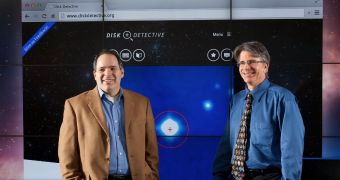Officials at the NASA Goddard Space Flight Center (GSFC), in Greenbelt, Maryland, have just launched a new website, called Disk Detectives, which calls on the general public to aid the American space agency in discovering embryonic planetary systems hidden in a massive database.
The vast volume of information was collected over nearly two years by the NASA Wide-field Infrared Survey Explorer (WISE) mission, which conducted almost two whole-sky surveys in IR wavelengths.
Between 2010 and 2011, WISE captured images of more than 745 million objects scattered throughout the night sky. Some of these objects, researchers say, are planetary nurseries, areas where new stars are currently being formed, and where extrasolar planets may be developing.
The purpose of Disk Detectives is to create a comprehensive catalog of candidate locations where this phenomenon might be occurring. The overarching goal here is two-fold: produce publishable results, and identify targets for mission such as Hubble and the James Webb Space Telescope.
This is the largest crowdsourcing project that NASA has ever attempted, but its scale is justified by the sheer volume of data that need to be cataloged. WISE did not just image planetary and stellar nurseries, but also galaxies and other cosmic objects. Identifying planetary nursery candidates is like looking for very small needles in a massive haystack.
“Through Disk Detective, volunteers will help the astronomical community discover new planetary nurseries that will become future targets for NASA's Hubble Space Telescope and its successor, the James Webb Space Telescope,” explains the chief scientist at the GSFC Sciences and Exploration Directorate, James Garvin.
According to astronomers, many new stars may be born with protoplanetary disks around them, which are sprawling areas filled with dust and gas that can generate new planets. The dust at these locations absorbs light from the parent stars, and then re-radiate it as heat. WISE was extremely sensitive to these specific wavelengths.
“Planets form and grow within disks of gas, dust and icy grains that surround young stars, but many details about the process still elude us. We need more examples of planet-forming habitats to better understand how planets grow and mature,” explains GSFC astrophysicist Marc Kuchner.
Unfortunately for NASA scientists, the same IR signature released by protoplanetary disks is released by other cosmic objects, such as galaxies, nearby asteroids, or inter- and intra-galactic dust clouds. Computer software are simply not sensitive enough to tell the difference, but humans are.
“Disk Detective's simple and engaging interface allows volunteers from all over the world to participate in cutting-edge astronomy research that wouldn't even be possible without their efforts,” concludes the director of citizen science at the Adler Planetarium in Chicago, Laura Whyte.

 14 DAY TRIAL //
14 DAY TRIAL //